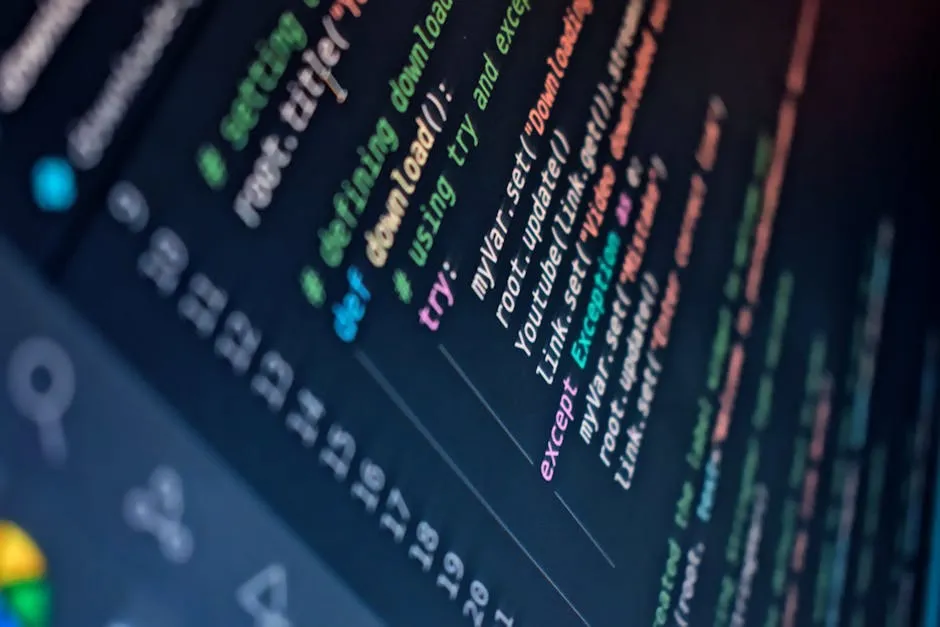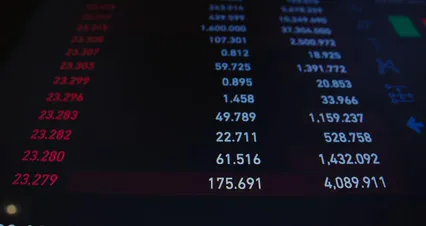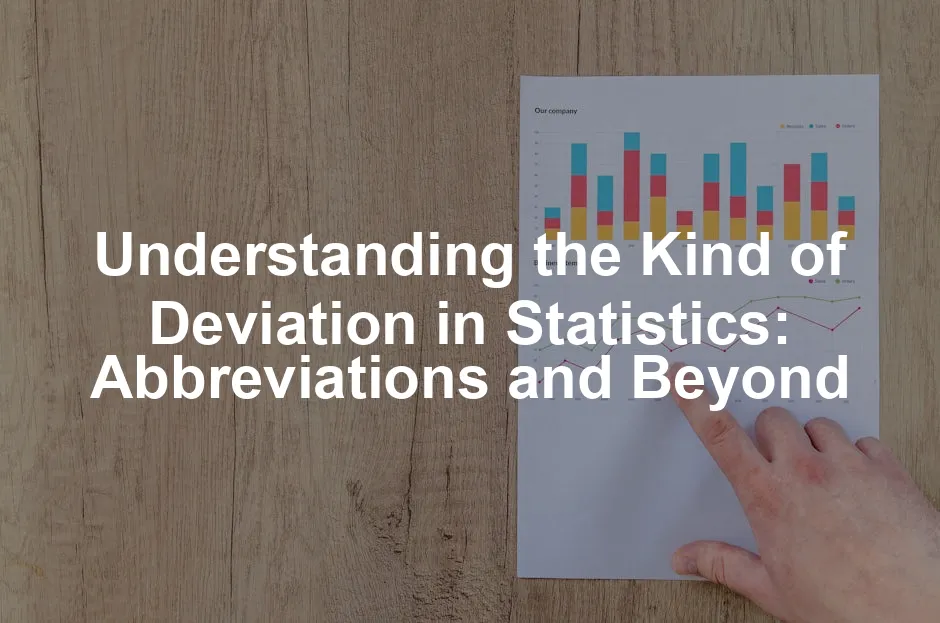Introduction
Statistics can be a bit like a rollercoaster ride. There are twists, turns, and sometimes, a deviation from the expected path. One of the key concepts in statistics is deviation. But what exactly does it mean?
Deviation measures how far individual data points differ from the average or mean of a dataset. Imagine a classroom where most students score around 75% on a test, but one student scores a 30%. That’s a significant deviation! Understanding these disparities is crucial in data analysis. It helps researchers and analysts identify trends, outliers, and patterns that could influence decision-making.
When it comes to deviation, one abbreviation stands tall: “STD.” This commonly recognized abbreviation stands for standard deviation. It’s not just a fancy term; it’s a vital tool in statistics. By grasping the ideas behind deviations, including standard deviation, you’ll unlock deeper insights into your data.
This article aims to unpack various types of deviations in statistics. We’ll explore their significance and practical applications, ensuring you leave with a clear understanding. So, buckle up as we navigate through the fascinating world of statistical deviation!
What is Deviation in Statistics?
Definition of Deviation
In statistics, deviation refers to the difference between each data point and the mean of a dataset. It’s like measuring how far each student strays from the average score in our classroom example.
Mathematically, deviation is calculated by subtracting the mean from each data point. If your mean score is 75%, and one student scored 30%, the deviation for that student is -45%. This negative value indicates they fall below the average. Conversely, if another student scores 90%, their deviation is +15%. Positive deviations show scores above the mean.
Types of Deviation
Now that we’ve defined deviation, let’s introduce some common types:
- Absolute Deviation: This measures the absolute difference between each data point and the mean, ignoring whether it’s above or below. It’s calculated as the absolute value of the deviations. For example, if our two students scored 30% and 90%, their absolute deviations would be 45% and 15%, respectively.
- Variance: Variance is the average of the squared deviations from the mean. Squaring the deviations prevents negative values from cancelling out. This measure helps assess data spread and is foundational for calculating standard deviation.
- Standard Deviation: Often abbreviated as “STD,” this is the square root of variance. It provides a measure of how spread out the data points are around the mean. A low standard deviation indicates that the data points are close to the mean, while a high standard deviation signifies a wider spread. In our classroom, if most students score between 70% and 80%, the standard deviation will be low. But if scores range from 30% to 90%, the standard deviation will be high.
By understanding these various types of deviation, you can better interpret data and make informed decisions based on statistical analysis. Remember, deviation isn’t just a number; it tells a story about your data’s behavior.

Understanding Standard Deviation
What is Standard Deviation?
Standard deviation (SD) measures data set variability. It tells us how much individual data points deviate from the mean. Picture a group of friends with varying heights. If most are around six feet tall, but one is only five feet, that friend has a significant deviation!
Mathematically, standard deviation is represented by the Greek letter sigma (σ) for population and the Latin letter “s” for samples. The formula for population standard deviation is:
σ = √(1/N ∑(X_i - μ)²)Here, N is the total number of data points, X_i represents each individual data point, and μ is the mean of the dataset.
For sample standard deviation, the formula adjusts slightly:
s = √(1/(n-1) ∑(x_i - x̄)²)In this case, n is the sample size, and x̄ is the sample mean. The difference in formulas accounts for the smaller sample size, providing a more accurate estimate of the population’s variability.
Importance of Standard Deviation
Standard deviation is crucial in statistics. It helps us understand data distribution. A low standard deviation means that data points are close to the mean. In contrast, a high standard deviation indicates a wider spread. This information is vital in many fields, including finance and research, where understanding variability can significantly impact decisions.
Identifying outliers is another essential function of standard deviation. Outliers are data points that deviate significantly from the rest. For instance, if most students score between 70 and 80 on a test, but one scores 30, that score is an outlier. Standard deviation helps to flag these unusual points, allowing analysts to investigate further.
Calculating Standard Deviation
Formulae and Calculation Steps
To calculate standard deviation, follow these steps:
- Find the Mean: Sum all data points and divide by the total number of points.
- Calculate Deviations: Subtract the mean from each data point. This gives you the deviations.
- Square the Deviations: Square each deviation to eliminate negative values.
- Average the Squared Deviations:
- For population: Divide the sum of squared deviations by N.
- For sample: Divide the sum by n-1.
- Take the Square Root: Finally, take the square root of the result from the previous step. This gives you the standard deviation.
Let’s illustrate this with an example:
Consider the heights of five friends: 5.5, 6.0, 5.8, 6.2, and 5.9 feet.
- Calculate the Mean:
Mean = (5.5 + 6.0 + 5.8 + 6.2 + 5.9) / 5 = 5.84 - Calculate Deviations:
- 5.5 – 5.84 = -0.34
- 6.0 – 5.84 = 0.16
- 5.8 – 5.84 = -0.04
- 6.2 – 5.84 = 0.36
- 5.9 – 5.84 = 0.06
- Square the Deviations:
- (-0.34)² = 0.1156
- (0.16)² = 0.0256
- (-0.04)² = 0.0016
- (0.36)² = 0.1296
- (0.06)² = 0.0036
- Average the Squared Deviations:
- Sum = 0.1156 + 0.0256 + 0.0016 + 0.1296 + 0.0036 = 0.276
- For sample SD: 0.276 / (5-1) = 0.069
- Square Root:
s = √(0.069) ≈ 0.263
So, the sample standard deviation is approximately 0.263 feet. This value indicates how much variation exists in the heights of these friends. Understanding standard deviation can turn confusing data into meaningful insights, making it an essential concept in statistical analysis.

Other Related Abbreviations
When it comes to discussing types of deviation in statistics, a few abbreviations deserve the spotlight alongside the well-known “STD” for standard deviation. Let’s take a quick peek at two other pivotal abbreviations: “VAR” and “MAD.”
- VAR: This abbreviation stands for Variance. Variance measures how far a set of numbers is spread out from their average value. Imagine you’re at a birthday party, and everyone is dancing around. If everyone is clustered near the cake, the variance is low. However, if folks are scattered all over the yard, the variance is high! Understanding variance is essential as it lays the groundwork for calculating standard deviation. A higher variance indicates greater dispersion, while a lower variance suggests that most data points are close to the mean.
- MAD: This stands for Median Absolute Deviation. Unlike standard deviation, which squares the differences from the mean (making it sensitive to outliers), MAD takes the absolute values of the deviations from the median. This gives it a robust nature, making it less affected by extreme values. Think of it as the chill friend at the party who doesn’t let drama get to them. By focusing on the median, MAD provides a clearer picture of data variability in skewed distributions.
Both VAR and MAD play critical roles in statistics, complementing the insights given by standard deviation. Together, they help analysts paint a comprehensive picture of data distributions, guiding better decision-making in research and beyond.

Applications of Standard Deviation
In Research and Data Analysis
Standard deviation is a superstar in various fields! Let’s explore how it plays a significant role in research and data analysis across disciplines like psychology, economics, and market research.
In psychology, researchers use standard deviation to understand variations in behavior or responses. For instance, when measuring anxiety levels among participants, a low standard deviation indicates that most individuals report similar anxiety levels. A high standard deviation reveals that responses are wildly different, hinting at diverse psychological conditions within the group. This insight can guide therapists in tailoring interventions based on the range of anxiety levels observed.
Moving to economics, standard deviation helps economists gauge market volatility. When analyzing stock prices, a high standard deviation suggests that prices are swinging dramatically over time. Investors use this information to assess risk. If the stocks are all over the place, they might think twice before investing their hard-earned cash. On the flip side, a low standard deviation indicates stability, making those stocks more appealing.
In market research, businesses rely on standard deviation to interpret consumer preferences. For example, if a company conducts a survey about a new product, they might find that most responses cluster around a specific rating. A low standard deviation indicates that consumers generally feel similarly about the product. If the standard deviation is high, it shows mixed feelings, prompting the company to rethink their marketing strategy or improve the product before launch.
Understanding data analysis techniques for economics and statistics students can enhance your ability to apply standard deviation in practical scenarios.

Real-Life Examples
Now, let’s look at some real-life examples where standard deviation proves its worth in decision-making processes.
In finance, standard deviation is crucial for risk assessment. For instance, a financial analyst evaluates two investment portfolios. Portfolio A has a standard deviation of 5%, while Portfolio B has 15%. The higher standard deviation of Portfolio B signals greater risk. Investors might prefer Portfolio A for its stability, opting for lower risk and potentially lower returns. Alternatively, risk-tolerant investors might jump at the chance for higher returns despite the volatility of Portfolio B.
Another example can be found in sports analytics. Coaches and teams often analyze player performance metrics using standard deviation. A basketball player’s shooting percentage might have a low standard deviation, suggesting consistent performance. Conversely, if a player shows high variability in their scoring, the coach might need to adjust their training or game strategy. By understanding these metrics, teams can make informed decisions on player development and game tactics.
In essence, standard deviation is a powerful tool that helps professionals across disciplines make sound decisions based on the variability of their data. By understanding and applying this concept, they can navigate uncertainties with greater confidence, whether in finance, sports, or any other field!

Common Misconceptions about Standard Deviation
Misunderstanding its Meaning
Ah, standard deviation! It’s a term that sounds fancy but often gets misunderstood. Many think it simply measures how spread out numbers are. While that’s true, it’s also about how much individual data points differ from the mean.
Let’s clear up some myths. First, standard deviation is not just a single number. It’s a reflection of data variability. A low standard deviation means most data points are close to the mean. High standard deviation? Well, that means your data is throwing a party all over the place!
Another common misconception is that standard deviation can be negative. Nope! Standard deviation is always zero or positive. Think of it like a distance: you can’t have a negative distance, right?
Some folks also confuse standard deviation with variance. Variance is like standard deviation’s nerdy cousin. It’s the average of the squared deviations from the mean. To get the standard deviation, just take the square root of the variance. Easy peasy, right?
If you’re looking to dive deeper into the world of statistics, consider picking up Statistics for Dummies. It’s a great starting point that breaks down complex concepts into bite-sized pieces, perfect for beginners!
In essence, understanding standard deviation goes beyond just knowing its value. It’s about grasping what that number tells you about your data.

Importance of Context
Now that we’ve tackled some misconceptions, let’s talk about context. The value of standard deviation doesn’t exist in a vacuum. It needs context to make sense.
Consider this: a standard deviation of 10 might seem large in one dataset but small in another. If we’re talking about test scores, a standard deviation of 10 could indicate that students are scoring wildly differently. But in a dataset of incomes, it might mean that most people earn between $50,000 and $60,000.
The context helps you interpret whether a standard deviation is significant. A high standard deviation in a clinical trial could indicate a need for further investigation. In contrast, a high standard deviation in sports stats might just be a sign of varying performance levels among players.
Furthermore, comparing standard deviations between different datasets can be misleading. Different datasets might have different means, which affects the interpretation of their standard deviations. Always consider the context!
Understanding standard deviation is not just about the number—it’s about the story behind the data. When you grasp this, you begin to see the real value of statistical analysis.

Conclusion
In summary, standard deviation is a crucial aspect of statistical analysis. We debunked some common misconceptions, emphasizing that it’s not just a number but a measure of variability and distance from the mean.
We also highlighted the importance of context when interpreting standard deviation values. Without context, the number can be misleading.
Understanding these concepts can significantly enhance your data interpretation skills, whether you’re a researcher, analyst, or simply someone curious about statistics. By applying these ideas in real-life scenarios, you’ll gain a deeper insight into data behavior, making you a more informed decision-maker.
So, the next time you come across standard deviation, remember: it’s not just a statistic; it’s a window into the data’s soul. Embrace the nuances of standard deviation, and watch your analytical skills soar!

FAQs
What is the difference between variance and standard deviation?
Variance and standard deviation are closely related but distinct concepts. Variance measures the average squared deviations from the mean, showing how much the data points spread out. It’s like measuring how far each student strays from the average score, but in squared terms. Standard deviation, on the other hand, is the square root of variance. It reverts those squared values back to the original units, making it easier to interpret. If the variance is 16, the standard deviation is 4. In essence, variance gives you a broad view of data spread, while standard deviation provides a more digestible figure for understanding variability.
Why is the standard deviation considered a measure of risk?
In finance and investment, standard deviation serves as a critical gauge of risk. A higher standard deviation indicates greater volatility in an asset’s returns, which can lead to unpredictable outcomes. Imagine investing in two stocks. Stock A has a standard deviation of 5%, while Stock B’s is 15%. Stock B is riskier due to its higher price fluctuations. Investors often seek assets with lower standard deviations for stability. Those willing to embrace risk might choose higher standard deviation investments, hoping for higher returns. Understanding this relationship is vital for making informed financial decisions.
Can standard deviation be negative?
Nope, standard deviation can never be negative. Why, you ask? Because it’s a measure of distance, and distances can’t be negative. Standard deviation quantifies how much data points deviate from the mean, and since you’re dealing with squared values, the results are always zero or positive. If a dataset shows a standard deviation of zero, that means all data points are identical. But any positive value indicates some variation among the data. So, rest assured, standard deviation will always maintain its positive nature!
How does sample size affect standard deviation?
Sample size plays a significant role in the calculation of standard deviation. Generally, larger samples provide a more accurate estimate of the population standard deviation. Why? Because larger samples tend to capture more variability, leading to a more precise representation of the population. In smaller samples, the standard deviation can fluctuate more, resulting in potential inaccuracies. This is why statisticians often use Bessel’s correction (dividing by n-1 instead of n) when calculating sample standard deviation. It helps account for the added uncertainty in smaller datasets, ensuring a more reliable estimate.
What are some tools to calculate standard deviation?
Several tools can help you calculate standard deviation, making your life easier. Popular software includes: – **Excel**: Use the `STDEV.P` function for population standard deviation and `STDEV.S` for sample standard deviation. – **R**: The `sd()` function provides a straightforward way to calculate standard deviation in your datasets. – **Python**: Libraries like NumPy and Pandas offer built-in functions, such as `numpy.std()` or `DataFrame.std()`, to compute standard deviation quickly. – **Online Calculators**: Various websites also provide free calculators that can compute standard deviation for you. Using these tools simplifies the process, letting you focus on analyzing your data rather than crunching numbers!
If you’re interested in delving deeper into data analysis, check out The Data Science Handbook. It’s an excellent resource for anyone looking to expand their knowledge in the field!
Please let us know what you think about our content by leaving a comment down below!
Thank you for reading till here 🙂
All images from Pexels




